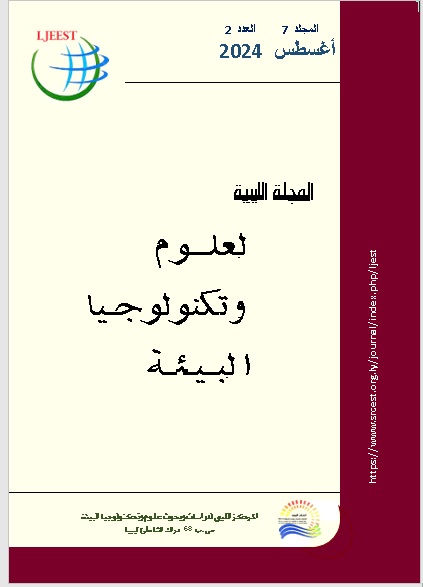الخصائص الفيزيوكيميائية والحيوية لترب مجاري بعض الوديان الداخلية بوادي الشاطئ ليبيا
DOI:
https://doi.org/10.63359/jftmqt82الكلمات المفتاحية:
ترب حديثة التكوين ، الإيصالية الكهربائية، النشاط الميكروبي، المادة العضوية، وادي تاروت ووادي حي هويديالملخص
تتواجد الترب حديثة التكوين Entisols ﻓﻲ ﺍﻻجزاء ﺍﻟﻤﻨﺨﻔﻀﺔ طبوغرافيا من وادي الشاطي. وهى ترب تتصف بانها ترب حديثة التكوين مما يؤثر على محتواها من المغذيات الضرورية لنمو النباتات التي تتأثر كميتها ونوعيتها بالخصائص الفيزيوكيميائية والحيوية للتربة كالنسجة والتركيب والكثافة الظاهرية والحقيقية والمسامية وغيرها، مما يؤثر بالتالى على التنوع الحيويى والغطاء النباتي بها .ان التعرف عاى هذه الخصائص يعطي مؤشراً عن تأثيراتها الايجابية أو السلبية على تنوع وكثافة الغطاء النباتي بها، حيث تختلف الترب بتغير موقعها، كما تلعب الظروف الجيولوجية والطوبوغرافية والمناخية والموارد المائية عاملا مهم في تشخيص خصائصها الفيزوكيميائية والحيويى . وتبرز اهمية دراسة خصائص ترب مجاري بعض الوديان الدخلية في منطقة وادي الشاطي ومعرفة خصائصها في تحديد دورها على انها مورد طبيعي قابل للاستثمار المستمر و التعامل معها على أسس علمية سليمة تضمن تحسين خواصها وصيانتها والمحافظة عليها وامكانية ديمومتها كمورد طبيعي مهم. حيث تهدف هذه الدراسة إلى معرفة الخصائص الفيزيوكيميائية والحيوية لترب مجاري بعض الوديان الداخلية بوادي الشاطي- ليبيا. تم إجراء التحاليل الفيزيوكيمائية لترب مجرى واديين داخليين هما وادي تاروت ووادي ققم. حيث تبين النتائج ود تباين في خصائص ترب مجى كلا الواديين ، حيث تراوحت النسبة المؤية للمادة العضوية في ترب مجرى وادي تاروت بين 1.2-2% وما بين 1.3-2.8% لترب مجري وادي ققم، كما اختلفت الكثافة الحقيقة لترب مجري الواديين ، حيث كانت بين 2.3-2.7 جم/سم3 لترب مجرى وادي تاروت و2.3 -2.8 جم/سم3 لترب مجرى وادي ققم. كما اختلفت قدرتهما على الاحتفاظ بالماء ، حيث تراوحت بين 10.6-14% لترب مجرى وادي تاروت و 9.4-15% لترب مجرى وادي ققم. كما تميزت ترب مجرى الواديين بارتفاع قيم الايصالية الكهربية بها والتى ترواحت لترب مجرى وادي تاروت بين 24.5- 84.4 dS/m-1 ، اما لترب مجرى وادي ققم فكانت بين 4.20 -10.60 dS/m-1 ، اما الاس الهيدوجين فقد كان متعادلا تقريبا لكلا ترب مجري الواديين (6.9-7.3) و(7.2-7.6) لترب مجرى وادي تاروت ووادي ققم على التوالى، وسجل ارتفاع في تركيز ايون الصوديوم فكان بين (4.8 -39.00 ملجم/ لتر) وبين (14.6-36.00 ملجم/ لتر) لترب مجري الواديين على التوالى، واحتوت ترب مجرى وادي تاروت على (3-35.2 ملجم/ لتر) من البوتاسيوم اما في ترب مجرى وادي ققم فتراوح مابين 5.8-9.00 ملجم/ لتر ، ومن هذه الدراسة نستنتج أن الظروف البيئية لمجرى كلا الواديين الداخليين كالجفاف الشديد أو ارتفاع درجة الملوحة تعمل على انتقاء الانواع النباتية القادرة فقط على التكيف مع الظروف البيئية المحيطة.
المراجع
Abdelfattah, M. A., Shahid, S. A., & Othman, Y. R. (2009). Soil salinity mapping model developed using RS and GIS—a case study from Abu Dhabi, United Arab Emirates. European Journal of Scientific Research, 26(3), 342-351. https://doi.org/10.2136/sh2009.1.0003
Adams, M. B., Peterjohn, W. T., & Gilliam, F. S. (2006). Acidification and nutrient cycling. In The Fernow watershed acidification study (pp. 207-236). Dordrecht: Springer Netherlands. https://doi.org/10.1007/1-4020-4615-4_7
Aishah, M. R., Alshebani, A. K., Romdan, A. A., & Panhwar, Q. A. (2022). Using different organic wastes to improve the quality of desert soils and barley (Hordeum vulgare) plant growth. Int. J. Sci. Res. Arch, 6, 193-205 .https://doi.org/10.30574/ijsra.2022.6.2.0161
Aishah, R. M. and Elssaidi, M. A. (2020). Soil and Water Physical & Chemical Properties of Tragen Sabkha Area, Southwest Libya. Sciences 35 (1): 46-59 . https://doi.org/10.2166/wpt.2024.163
Aishah, R. M., & Elssaidi, M. A. (2019). Using Pollution Indices to Assess Heavy Metals Contaminated Soil in some Libyan Regions. Libyan Journal of Ecological & Environmental Science and Technology (LJEEST), 1(1), 38-49. https://doi.org/10.63359/xscykm31
Alam, M. Z., Das, D. K., Hashem, M. A., & Hoque, M. A. (2016). Soil amendments with farm yard manure and poultry manure confer tolerance to salt stress in rice (Oryza sativa L.). Research in Agriculture Livestock and Fisheries, 3(3), 379-386. https://doi.org/10.3329/ralf.v3i3.30728
Albireeki, M. H., Soliman, M. S., & Mohamed, A. R. (2019). Effect of Sodium Fluoride on Germination Seedling Growth in Wheat (Triticum aestivum) VAR UP2382. Libyan Journal of Ecological & Environmental Science and Technology (LJEEST)1(1), 25-33. https://doi.org/10.63359/tqkn4t09
Barik, T., Behera, B., Jena, S. N., Roul, P. K., & Satapathy, M. R. (2015). Crop nutrition and productivity of maize and cowpea intercropping system under different management practices. E planet, 13(2), 37-44. https://doi.org/10.56739/jor.v37ispecialissue.140812
Baruah, T.C. and Barthakur, H.P. 1997. A textbook on Soil Analysis. Vikas Publishing House PVT LTD, 576 Masjid Road, Jangpura, New Delhi 110 014. https://doi.org/10.1163/157254397x00115
Braun-Blanquet, J., Roussine, N., & Nègre, R. (1951). The plant communities of Mediterranean France. CNRS, Paris. https://doi.org/10.1080/12538078.2015.1108868
Chi, Z., Wang, W., Li, H., Wu, H., & Yan, B. (2021). Soil organic matter and salinity as critical factors affecting the bacterial community and function of Phragmites australis dominated riparian and coastal wetlands. Science of The Total Environment, 762, 143156. https://doi.org/10.1016/j.scitotenv.2020.143156
Demmig‐Adams, B., & Adams III, W. W. (2006). Photoprotection in an ecological context: the remarkable complexity of thermal energy dissipation. New phytologist, 172(1), 11-21. https://doi.org/10.1111/j.1469-8137.2006.01835.x
Eusufzai, M. and Fujii, K. (2012) Effect of Organic Matter Amendment on Hydraulic and Pore Characteristics of a Clay Loam Soil. Open Journal of Soil Science, 2, 372-381. https://doi.org/10.4236/ojss.2012.24044
Eusufzai, M. K., &, K. (2012). Effect of organic matter amendment on hydraulic and pore characteristics of a clay loam soil. https://doi.org/10.4236/ojss.2012.24044
Farida, Y.M and Aishah, R. M.,( 2023): Phytoremediation of Salinity Affected Soils. Libyan Journal of Ecological & Environmental Sciences and Technology (LJEEST), June, 2024
Hillel, D., & Hatfield, J. L. (Eds.). (2005). Encyclopedia of Soils in the Environment (Vol. 3). Amsterdam, The Netherlands: Elsevier. https://doi.org/10.1016/b0-12-348530-4/90035-3
Kamal, A., Ahmad, M. S. A., Alvi, A. K., Hameed, M., Ahmad, F., & Ghaffar, K. (2021). Soil salinity differentially influences soil physicochemical properties and nutrient availability in rhizospheric soils of grasses growing in hyper-saline-arid regions. Soil & Environment, 40(1). https://doi.org/10.1080/15324989709381487
Laity, J. J. (2009). Deserts and desert environments (Vol. 3). John Wiley & Sons. https://doi.org/10.1111/j.1475-4959.2009.00347_6.x
Lymbery, A. J., Kay, G. D., Doupé, R. G., Partridge, G. J., & Norman, H. C. (2013). The potential of a salt-tolerant plant (Distichlis spicata cv. NyPa Forage) to treat effluent from inland saline aquaculture and provide livestock feed on salt-affected farmland. Science of the Total Environment, 445, 192-201. https://doi.org/10.1111/geoj.2009.175.issue-4
Manlay, R. J., Feller, C., & Swift, M. J. (2007). Historical evolution of soil organic matter concepts and their relationships with the fertility and sustainability of cropping systems. Agriculture, Ecosystems & Environment, 119(3-4), 217-233. https://doi.org/10.1016/j.agee.2006.07.011
Meena, M. (2023). A Geographical Study of Deserts. European journal of innovation in nonformal education, 3(7), 219-238. https://doi.org/10.15294/jne.v9i1.42720
Munsell, A. H. (2000). Munsell soil color charts. Gretagmacbeth. https://doi.org/10.5040/9781501327551.0006
Paudel, S., & Vetaas, O. R. (2014). Effects of topography and land use on woody plant species composition and beta diversity in an arid Trans-Himalayan landscape, Nepal. Journal of Mountain Science, 11, 1112-1122. https://doi.org/10.1007/s11629-013-2858-3
Perie, C., & Ouimet, R. (2008). Organic carbon, organic matter and bulk density relationships in boreal forest soils. Canadian journal of soil science, 88(3), 315-325. https://doi.org/10.4141/cjss06008
Piper, J. (1987). Interaction forces between soil particles: shear moduli of the< 2 μm size fraction. Journal of Soil Science, 38(1), 1-11. https://doi.org/10.1111/j.1365-2389.1987.tb02117.x
Riaz, U., Murtaza, G., Saifullah, F. M., & Farooq, M. (2018). Comparable effect of commercial composts on chemical properties of sandy clay loam soil and accumulation of trace elements in soil-plant system. Int J Agric Biol, 20(1), 85-92. https://doi.org/10.1002/ldr.2925
Rice, E. W., Bridgewater, L., & American Public Health Association (Eds.). (2012). Standard methods for the examination of water and wastewater (Vol. 10). Washington, DC: American public health association. https://doi.org/10.1002/j.1551-8833.1932.tb18153.x
Rivenshield, A., & Bassuk, N. L. (2007). Using organic amendments to decrease bulk density and increase macroporosity in compacted soils. Arboriculture and Urban Forestry, 33(2), 140. https://doi.org/10.48044/jauf.2007.015
Rump, H. H., & Krist, H. (1988). Laboratory manual for the examination of water, waste water and soil (pp. xi+-190). https://doi.org/10.1097/00010694-198911000-00012
Wang, Y., Xie, M., Hu, B., Jiang, Q., Shi, Z., He, Y., & Peng, J. (2022). Desert Soil Salinity Inversion Models Based on Field In Situ Spectroscopy in Southern Xinjiang, China. Remote Sensing, 14(19), 4962. https://doi.org/10.3390/rs14194962 .
التنزيلات
منشور
إصدار
القسم
الرخصة
الحقوق الفكرية (c) 2025 المجلة الليبية لعلوم وتكنولوجيا البيئة (م ل ع ت ب)

هذا العمل مرخص بموجب Creative Commons Attribution-NonCommercial 4.0 International License.















